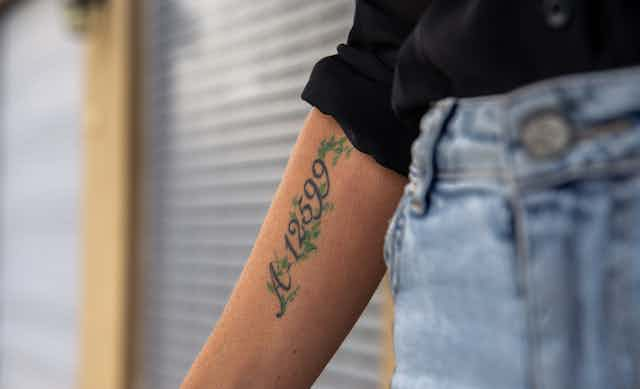Rony Cohen doesn’t remember any particular moment when she first became aware of the number tattooed on her grandmother’s arm. It was just always there.
Cohen says she felt as if she had experienced the Holocaust herself, in a different cycle of her own life. It featured in her dreams. It permeated family life, as did the self-imposed interdiction on talking about the past and the absence of relatives. The legacy of starvation was never far from the surface. Food was used to soothe. There was no waste. Her grandfather finished every crumb from every plate.
The impact the Holocaust has had through the generations runs deep. Quite how we remember the past and its legacy varies hugely. Cohen is one of a small but growing number of the children and grandchildren of Holocaust survivors who have replicated the Auschwitz death camp tattoo on their own body.

Auschwitz, in Nazi-occupied Poland, was the only camp where numbers were tattooed on those inmates not selected for immediate death. In replacing the person’s name, this number has become the visual symbol of the crimes of the Nazis.
Cohen draws meaning from her tattoo in that it signifies her grandmother’s history and her own identity as a descendant of Holocaust survivors. To her mind, replicating this number was a means of taking her grandmother, as a person, and her legacy forward. As a gesture and an indelible mark she carries with her, she says:
The number is my grandma. It’s my past, my roots, my story. It’s who I am.
A potent gesture
My research delves into the stories of those descendants who, like Cohen, have chosen to replicate a parent or a grandparent’s tattoo on their own body. Of the 16 people I have spoken with, 13 are from Israel and three from the US.
As the number of remaining survivors of the Nazi concentration camps grows ever smaller and the Holocaust passes out of living memory, replicating an Auschwitz tattoo becomes an ever more potent gesture about embodied memorialisation and, crucially, familial ties and love.
The people I have spoken with have relayed complex and varied decision-making processes behind this potent gesture. Some waited until their survivor parent or grandparent had died. Some got the tattoo without seeking approval. Others discussed doing so with their relative, beforehand.

The replica tattoos they have each opted for vary in terms of font, colour and placement. Some have chosen to replicate exactly what the original looked like and where it was placed. Others have chosen to alter the designs in detail and colour, or to place it on a different part of their body. Each decision crafts the meaning of the new tattoo.
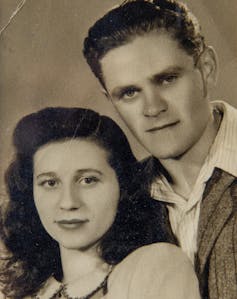
In the summer of 2022, I met with Orly Weintraub Gilad on Zoom. She had chosen to have her maternal grandfather Samuel Kestenbaum’s number tattooed on her arm, but it was also for her maternal grandmother, Agi Kestenbaum. She had been in Auschwitz too, but was not tattooed because she was not expected to live.
Like Cohen, Weintraub Gilad doesn’t remember a specific time when she first noticed her grandfather’s number, but the stories about the Holocaust were a part of her life from childhood. She says her mother, who died eight years before we spoke, used to talk a lot about the Holocaust. “She knew everything,” Weintraub Gilad says.
All four of her grandparents had survived the Holocaust. Her paternal grandparents died when she was in her late teens and even now, she says, her father doesn’t talk about what they experienced. She says that when she asks her father questions, he doesn’t know the answers.
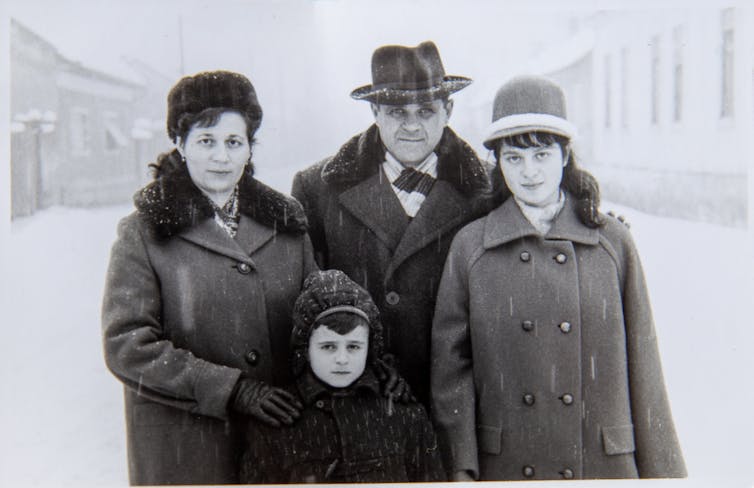
Weintraub Gilad remains very close to her grandmother, who is 95 years old. The tattoo gives her the chance to continue what her mother used to do and talk about the Holocaust. “It starts the conversation and that’s the purpose,” she says, “that’s the thing that my grandmother is so happy about. She knows that after she’s gone, that I will talk.”
The tattoo itself features her grandfather’s number in a nest of leafy green vines. From different vines emerge letters, the initials of the names of Weintraub Gilad’s husband and her children. But the resulting composition is as much about her family’s history as it is about their collective future.
The choice of green vines and leaves came from her love of nature. Her grandfather’s number was on his left arm, but Weintraub Gilad placed her own tattoo on her right arm. She says she wanted “to do it the same but different”. One reason for choosing the right arm was because she did not want to see the number “on the side of the heart”.
That same summer, I spoke with Yair Ron (Reisz), also on Zoom. He grew up in Israel, on a kibbutz founded by Holocaust survivors. “It was a very small community of people with same idea of communism,” he recalls. “All of them were Holocaust survivors, so all of them have numbers.”
Growing up, no one on the kibbutz had grandparents or spoke about their suffering. Ron’s father, Jakub Reisz – whom everyone knew as Yakshi – said nothing about the Holocaust and, like many children of Holocaust survivors, Ron and his sister knew not to ask. Yakshi would talk about helping people escape from Slovakia to Hungary – but he never said a word about what he had experienced.
It was impossible to have a conversation about the Holocaust with my father. We were afraid to ask and afraid to hear. Maybe we didn’t want to hear. And he told us that he don’t want to tell, so we couldn’t exchange any information about the Holocaust whatsoever.
Ron first noticed his father’s number as a child. Just as it was normal not to talk about things – about families, generations, loss – it was also normal to him and his peers that adults had numbers on their bodies. Until he started venturing out into the local town as a teenager, he didn’t really meet people from outside of the kibbutz – adults, that is, who didn’t have numbers.
It seemed very natural to us that adults had numbers so we didn’t pay very much attention to this. We didn’t know other adults or people without numbers. The kibbutz was far away in the mountain, it was very isolated.

It was only after Yakshi’s death that Ron started to piece together his story. Coming across a letter and diary that a friend of his father’s had written, Ron discovered that both men had been deported from Slovakia to Auschwitz. They had then been taken to Nazi-run work camps, from where they were eventually liberated.
After their release, they started their journey back to Slovakia, via Prague. To pass through the British military area without being detained, identification was required. Neither man had any, so they tattooed what looked like Auschwitz numbers on their left arms. Ron shared what he had learned with his family. They were very proud of Yakshi, he says, praising his “creativity and thinking out of the box”.
Ron first thought about getting Yakshi’s number tattooed on his own body when he was around 50 years old, at the turn of the millennium. He discussed it with his father who, like most Holocaust survivors, was strongly opposed to the idea at first.

He says his relationship with his father was not an easy one. There were barriers between them. Ron ascribed these, in part, to Yakshi’s experiences of the Holocaust and the trauma he lived with. But it was more complex than that.
Kibbutzim in the 1950s and 1960s, like the one Ron grew up on, were often organised around collective-socialist principles. Until the 1980s, children were raised separately from their parents and slept in a communal children’s house. Research has shown variable attachment responses among those who grew up in this way – although it found little variation in attachment to fathers, compared with those who grew up in family homes.
Ron wonders, however, whether the fact that he and Yakshi did not enjoy a “normal” relationship is in some part due to growing up this way. Although he saw his father as a good man, the distance between them meant they could not speak about, as he puts it, “real feelings and thoughts”.
Having the number on his own body, Ron says, allowed him to reflect on what it is to live “like a numbered person”. As survivors die out, he dwells on the thought that soon there will be no numbered people. This, to his mind, makes the number an important thing to keep – a tool for keeping the memory alive.
Tattooing in Auschwitz
Serial number tattoos with symbols, shapes or letters were first introduced for prisoners in the Auschwitz concentration camp complex in October 1941. More than 400,000 people would be tattooed there. The exceptions were ethnic Germans, Austrians, police prisoners and Polish prisoners deported from Warsaw during the 1944 uprising – plus Jewish prisoners held for a short time while waiting to be moved to other camps.
Prior to tattoos, identification numbers had been sewn on to the prison uniforms. Soviet prisoners of war were the first group to be tattooed after larger numbers started to die and the other prisoners took the deceased’s clothing, making it impossible to keep accurate records.
Initially, the tattoos were placed on the left side of each prisoner’s chest. Those who did the tattooing used a metal stamp with changeable plates fitted with needles that formed numbers, then rubbed blue ink into the bleeding holes. This technique enabled guards and prisoners to tattoo the number on a prisoner’s body in a single action.
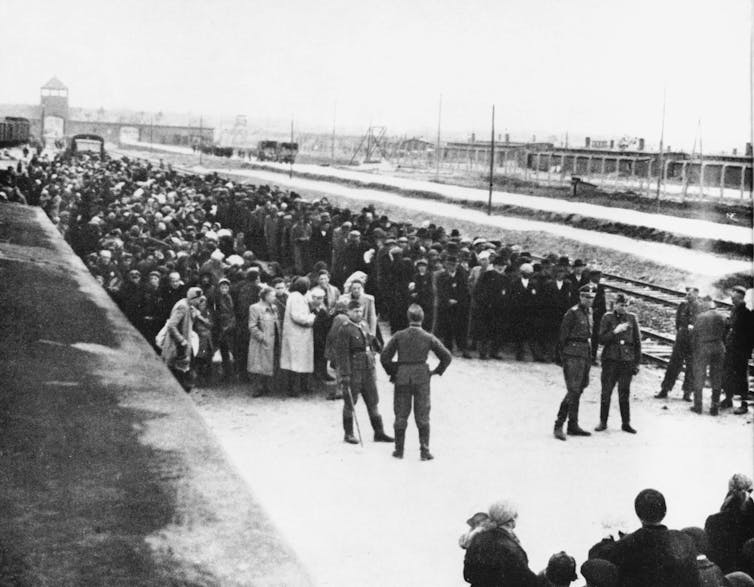
By the spring of 1942, all incoming Jewish prisoners selected for forced labour, rather than immediate death, were tattooed. In place of the metal plate, the tattooists now used a single needle to puncture the number into the prisoner’s skin by hand, then rubbed in the ink.
The numbers were tattooed on the prisoners’ left forearms. Shapes and letters were sometimes also used to differentiate between groups of prisoners. Some Jewish prisoners had a triangle tattooed under their number. Roma and Sinti prisoners had the letter Z appended to their number, the first letter of the (pejorative) German word Zigeuner, used at the time for these communities.
With Hungarian Jews arriving in increasing numbers, new sequences of digits were introduced in May 1944. These began with the number 1 and were prefaced first by the letter A; then, when more were needed, B.
In her 2001 autobiographical book, Still Alive: A Holocaust Girlhood Remembered, German studies scholar and Holocaust survivor Ruth Klüger describes the experience of getting forcibly tattooed in Auschwitz:
[After selection], we got our ID numbers tattooed on our left arms. A few female prisoners had been installed outside the building at a table with the necessary equipment and we stood in line, waiting our turn. The women knew their job, they were very fast. At first it looked as if the black ink would easily wash off, and indeed, water took most of it away, but then the fine points of the number remained: A-3537.
Klüger speaks about “the victims’ skin” saving the Nazis from having to “produce dog tags”. This underlines how dehumanising this Nazi practice of tattooing numbers on inmates was. As the Italian writer and Holocaust survivor Primo Levi puts it in his 1986 book, The Drowned and the Saved:
Its symbolic meaning was clear to everyone: this is an indelible mark, you will never leave here; this is the mark with which slaves are branded and cattle sent to slaughter, and that is what you have become. You no longer have a name; this is your new name.

An embodied public memorial
The Auschwitz number has marked out those who survived by making them ever recognisable to others. It is this recognition that mattered so much to Rony Cohen in getting her own tattoo:
I was proud to take my grandmother with me. To take her childhood, her missing her parents – those moments are in this number. Whenever someone sees it, they know this is Auschwitz. I want it to be noticed and understandable. No one should doubt what it is.
Cohen’s grandmother and great uncle were of the cohort of siblings that have become known as “Mengele twins”. The Nazi physician Josef Mengele had an interest in racial genetics. He first experimented on Roma and Sinti twins in what was known as the “Gypsy camp” in Auschwitz-Birkenau – then on Jewish prisoners who he picked from the Theresienstadt camp-ghetto in Terezín, in the Protectorate of Bohemia and Moravia.
From May 1944, subjects for Mengele’s experiments were also picked from the unloading ramps at Auschwitz. Cohen recalled the story her grandmother had told her, about how she arrived in Auschwitz with her twin brother, aged eight, and her mother and aunts and all the other children of the family:
They saw the smoke from the crematorium. The family was walking and someone was saying: ‘Twins, twins, twins – where’s twins?’
Instead of hiding them, her mother said to her aunts, “Let’s give them the twins”. Her aunts thought she was crazy for suggesting that – but her mother thought she was saving her children. “I’m going to save your life now,” she told her children. “Give mummy a hug and you’re leaving now.” This was the last moment Cohen’s grandmother could remember being with her mother.
Having made it through selection and been forcibly tattooed, twins were sometimes given additional food which helped keep them alive. First-hand accounts describe how Mengele gave his victims chocolate before carrying out the most horrific experiments. He sewed twins’ veins together, injected chemicals into testicles and spines, and inserted large needles into skulls.

This article is part of Conversation Insights
The Insights team generates long-form journalism derived from interdisciplinary research. The team is working with academics from different backgrounds who have been engaged in projects aimed at tackling societal and scientific challenges.
In the 1994 book, Anatomy of the Auschwitz Death Camp, a chapter by historian Helena Kubica recounts the testimony of one man, Moshe Ofer, who was imprisoned with his twin brother. His testimony was collected by the Jerusalem tribunal that tried Mengele in absentia in 1985. Mengele killed Ofer’s brother with his experiments.
Ofer describes how, after the experiments, the physician would bring gifts. The horror of that had never left him. “Even today,” he says, “I can see him entering through the door and I am paralysed with fear.”
Cohen’s grandmother similarly recalled Mengele bringing food for the twins. It saved them physically, she said, but the psychological damage was immeasurable. As Cohen puts it:
My grandmother, since the Holocaust, she has a sleeping disorder. In her dreams, her parents come and all the horror comes. She always tells me: ‘I can’t forgive myself that I remember Mengele’s face but I can’t remember my parents’ faces.’
Her brother – Cohen’s great uncle – had his tattoo removed after saving enough money. Her grandmother, by contrast, still bears it on her left arm.
As a child, Cohen would ask questions. Sometimes her grandmother would make out that it was nothing. Sometimes she’d say she would tell her when she was older. Cohen describes herself as stubborn – she just kept asking.
When she was 12 or 13, for a school project on roots, she decided to do a video on her family’s history. Cohen interviewed both her maternal grandparents. Her grandfather she describes as “tough”, with “all the characteristics of a typical survivor”. He was keen that Cohen pass on all the information to her mother because, he said, “Your mum never asked.”

Cohen shared everything with her mother and her uncle – and it finally removed the elephant from the room. It made talking about the Holocaust possible.
At 17, like so many Israelis, Cohen went on a high-school visit to Poland, to the camps and the ghettos. Before leaving on this trip, she went to see her grandfather. He told her that going to Auschwitz would change everything:
When you stand there in those walls and you smell the death smell and you see the gas chamber, you will come back to Israel and you will tell me: ‘I can’t understand.’
“I can’t understand,” Cohen now says. “My grandfather was so right.”
How Holocaust memorialisation has changed
The Auschwitz number tattoo was not always revered. After the second world war, survivors were often stigmatised. Public commemorations celebrated resistance and uprisings. The victims and survivors, by contrast, were portrayed as weak.
That early stigmatisation would follow some survivors throughout their lives, even when public perception started to shift. Some, like Cohen’s great uncle, had their number removed. Others covered it up with long sleeves.
From the early 1960s, as French historian Annette Wieviorka shows in The Era of The Witness (2006), attitudes began to change – partly due to the testimonies heard during the trial of Adolf Eichmann in 1961-62. The author Hannah Arendt reported from the district court in Jerusalem for the New Yorker magazine, thereby giving survivor voices a global platform. The trauma that emerged from Eichmann’s trial reframed survival in itself as something heroic.

Then, in 1967, Israel responded to threats from Egypt and other neighbouring states with an offensive that allowed it to expand into and occupy the Sinai Peninsula, the Gaza Strip, the West Bank, East Jerusalem and the Golan Heights. Further afield, the conflict – known as the six-day war – built an affinity between Jewish communities in the US and Israel. Many American Jews began to both embrace their European roots and support Zionism.
Wieviorka’s book highlights the third (and ongoing) phase of Holocaust memorialisation – what she terms the “era of the witness”, which emerged in the 1970s. People started collating survivor testimonies, photographs and documentation. Through visits to Poland, to the camps and ghettos, families began to tell their stories.
For some, the visit to Poland triggered the idea of replicating the Auschwitz number on their own body. In the summer of 2022, I spoke with Zeev Forkosh. Now aged 38, he has multiple tattoos – but the idea for his first one came after going to Auschwitz.
The new information Forkosh learned during that trip, about what his grandmother had experienced there, sparked such powerful emotions that he decided to get a Holocaust memorial tattoo. He describes the large Star of David he wears on his back as entwined with “bones, flesh and a lot of clothes, like the Holocaust survivors”.
Next, Forkosh decided to replicate his grandmother’s number on his arm, explaining:
I will never forget this trip, so it’s on my back now. But after a few years, I wanted to be more specific about my grandmother. I told the tattoo artist that this was for [her]. I’m a third generation of a Holocaust survivor. I think it’s the most beautiful tattoo ever.
Talking of this number in terms of beauty underscores how reproducing the tattoo gives it new meaning. It is a gesture that, for Forkosh, turns the visual symbol of a genocide into a symbol of love and legacy, of commemoration and pride.
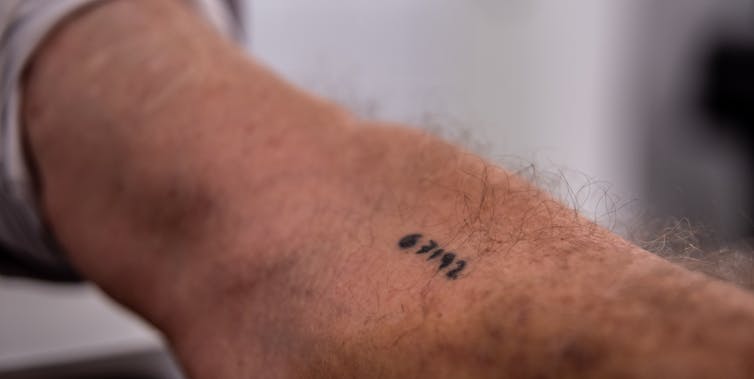
This marks a radical shift from survivors’ own relationships with the number. They had no choice in the matter: the tattoo was forcibly placed on their bodies. For some whose descendants suggested replicating it, the answer has always been a categorical “no”. Yair Ron discussed the idea with his father:
I tried to talk to him about the idea that I had to get the tattoo. He did not agree. ‘Why?’ he asked. ‘You don’t need to, it’s not good. Let’s forget everything.’
Ron kept trying: “It took a few years for us to talk about it. And then he agreed for me to do it.”
He gave the tattoo artist a photo of his father’s number. He wanted to replicate it as closely as possible. He wanted people to ask about it, to keep the Holocaust in living memory.
In Ron’s mind, this replicated number represents continuity. It ensures there are still people “walking with the number”. He says he wanted to experience what his father had experienced when his name was taken away.
Similarly, Rony Cohen says that deciding to replicate her grandmother’s tattoo was so “she could walk with me for good – it’s a statement for me”. Cohen too wanted it in the same place as the original, so that everyone understood its meaning. She sees her body as becoming a conduit for her grandmother – a means to keep her legacy and life with her at all times.
In contrast to Ron, though, Cohen did not broach the subject with her grandmother. She just went ahead and got the tattoo, then wore long sleeves at family gatherings – much like some survivors had in previous decades. But for her, covering the tattoo wasn’t because of stigma. Rather, she worried about the reactions it might trigger.
Eventually, Cohen decided to show the number to her grandmother. She videoed her response.
At first, her grandmother asks why Cohen has done it. Then she asks if it hurt. “I don’t want you to do something that hurts,” she says.
“No it didn’t,” Cohen replies.
To which her grandmother asks: “Why?”
Cohen is very clear that getting her tattoo was a personal act, a decision relating to her own history, not to a larger historical one. “I’m not a monument,” she says. “I don’t carry the Jewish nation on my back.”
When the Holocaust passes out of living memory
Museums and memorials all over the world are dedicated to telling the story of the Holocaust. Since 2006, International Holocaust Remembrance Day has been marked every year on January 27.
But despite the proliferation of Holocaust-related art and culture, despite the books laying out the facts, research shows many people are ignorant of what happened. In 2021, the global Holocaust Awareness Survey found large gaps in people’s knowledge.
In the UK, 52% of respondents could not specify that six million Jewish people had been murdered – a number which rose to 56% in Austria and 57% in France. Of the adults surveyed in the US and Canada, 45% and 49%, respectively, were unable to name a concentration camp or a ghetto. Among millennials in the US, only 49% could name a concentration camp or ghetto.

This matters because, as we reach the 79th anniversary of the liberation of Auschwitz on January 27 1945, there are very few survivors left to give a first-hand account of what was done to them. The Holocaust is passing out of living memory.
For those whose family history is tied up with the Holocaust, memorialising it is both public and private. The tattoo replicating the Auschwitz number is a form of memorial practice that speaks, viscerally, to their own family history – but also to the imperative to never forget.
I spoke with David Rubin in the summer of 2022. He bears his grandmother’s number on his arm, the number depicted as if written on a piece of wood alongside a Star of David, a thorny vine of lilac-coloured flowers entwined around it.
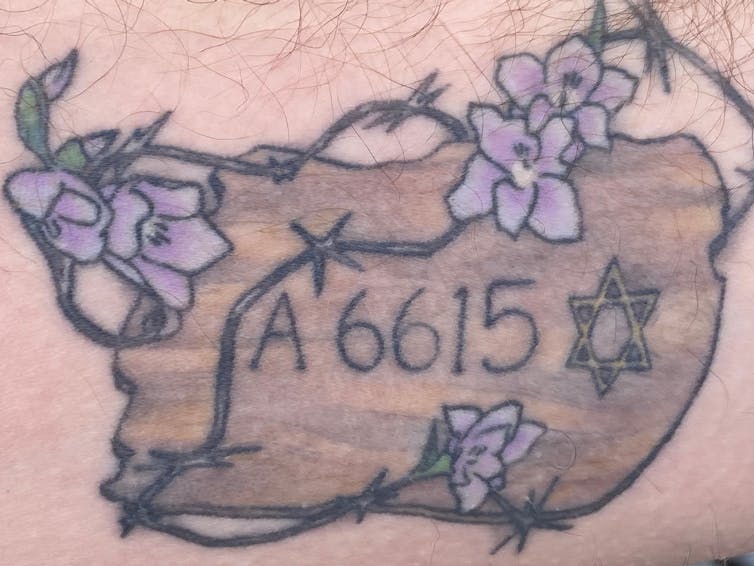
Four of the flowers are open, representing his grandmother, Piroska “Perl” Levy, and her surviving sisters. To the left lie two closed flowers, for her two sisters who were killed. A lone flower completes the floral framing at the bottom, in memory of her brother, also killed.
To Rubin’s mind, his generation is probably the last to speak about this. Getting the tattoo was a means of ensuring that the fourth generation – his children, his grandmother’s great-grandchildren – will know what happened. “I wanted a story, instead of just a number,” he says. The barbed wire has become the thorny vine in flower. “It’s taking the bad thing and [re]creating it as a good thing.”
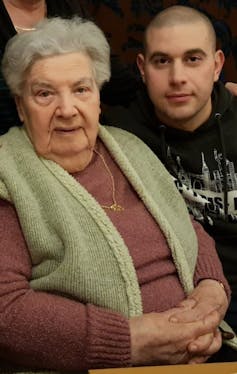
Memorial tattoos are a way of expressing a life story. They are an external scar that embodies an internal one. The writer Eva Hoffman notes that even where there are silences in how families, including her own, reckon with their traumatic past, the “language of the body” still breaches those silences. It keeps the unspoken past ever present.
While descendants of Holocaust survivors did not experience the trauma directly, the intergenerational trauma is long-lasting. Rony Cohen was not the only grandchild of a survivor who told me they dream or have nightmares about the Holocaust.
In doing these interviews, I have found that replicating the Auschwitz tattoo is an expression of the love felt towards the survivor relative, and a way of keeping the memory of the Holocaust alive. It is an act of reclaiming a painful family history. And for some, it is about connections to a collective identity.
In this way, it is about the future too. When there are no more survivors to share their stories, these descendants who bear on their living bodies the numbers once forcibly tattooed on their relatives will stand as a living reminder of where racism and hatred can lead.

For you: more from our Insights series:
To hear about new Insights articles, join the hundreds of thousands of people who value The Conversation’s evidence-based news. Subscribe to our newsletter.

